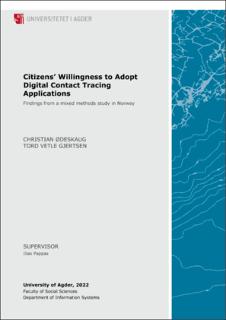| dc.description.abstract | Context: Early 2020, the SARS-CoV-2 (COVID-19) pandemic began to spread globally.
Digital contact tracing (DCT) applications began development soon after to help mitigate the
spread and contain this major crisis. In Norway, the application Smittestopp was developed to
fulfill the role as a digital solution. With a poor launch and little enforcement, less than half
of the population downloaded the application. This experience should be explored further by
the Norwegian government, in order to ensure successful digital solutions in the future.
Purpose: The purpose of this thesis is to explore Norwegians citizens’ willingness to adopt
Smittestopp, and if privacy concerns and human emotions affected these intentions. The way
we measured this was by looking at how; 1) privacy concerns, risk beliefs, trusting beliefs
and relative advantage impacts intention to use Smittestopp and 2) if human emotions
moderate the effects of these relations, thus, impacting intention to use Smittestopp.
Methods: Our mixed methods research consisted of expanding an existing literature review
and conducting a quantitative survey with a questionnaire. To complement the questionnaire
data, follow-up interviews were also conducted. The literature review served as a theoretical
foundation for our research, providing an overview of existing research on DCT-applications.
A research model was adopted from a previous study examining Australian citizens'
willingness to adopt the COVIDSafe-app. 9 hypotheses were developed to test suggested
construct relations. The questionnaire was developed in SurveyXact by adopting questions
from the aforementioned research paper, adjusting it for our research with the inclusion of
human emotions. We received 189 valid responses to the distributed questionnaire, and made
an interview guide aiming to complement and verify these responses further. We performed
interviews with 11 volunteers from the questionnaire. The questionnaire data was analyzed
using partial least squares structural equation modeling (PLS-SEM) in SmartPLS. The
interview transcripts were analyzed using Quirkos; a Computer-assisted Qualitative Data
Analysis Software (CAQDAS).
Results: All 9 hypotheses were validated and supported through an analysis of the
questionnaire data. These findings were later complemented by interview data, which verified
most of the hypotheses but also brought interesting and contradictory results. Most notably,
relative advantage significantly increased intention to use. Also, privacy concerns increased
risk beliefs, trusting beliefs decreased risk beliefs, and intention to use increased actual use.
Conclusion: We concluded that privacy concerns, trusting beliefs, risk beliefs and relative
advantage affected citizens’ intentions to use DCT-applications. Emotions moderate both
relative advantage and risk beliefs relations into intention to use. The findings explain why
Smittestopp was barely used, and how future digital solutions can learn from this.
Keywords: Digital contact tracing, COVID-19, information privacy concerns, trusting and
risk beliefs, relative advantage, human emotions, Smittestopp, e-governance, mixed methods. | |
